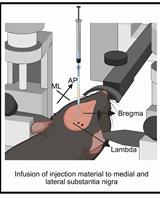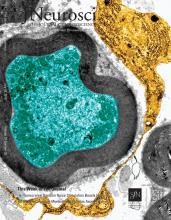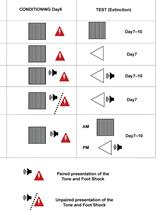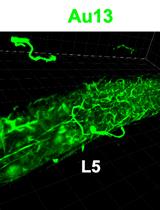- EN - English
- CN - 中文
Optic Nerve Crush in Mice to Study Retinal Ganglion Cell Survival and Regeneration
视神经挤压对小鼠视网膜神经节细胞存活和再生的影响
(*contributed equally to this work) 发布: 2020年03月20日第10卷第6期 DOI: 10.21769/BioProtoc.3559 浏览次数: 9964
评审: Oneil G. BhalalaXiaoyu LiuAnonymous reviewer(s)

相关实验方案

基于 rAAV-α-Syn 与 α-Syn 预成纤维共同构建的帕金森病一体化小鼠模型
Santhosh Kumar Subramanya [...] Poonam Thakur
2025年12月05日 1396 阅读
Abstract
In diseases such as glaucoma, the failure of retinal ganglion cell (RGC) neurons to survive or regenerate their optic nerve axons underlies partial and, in some cases, complete vision loss. Optic nerve crush (ONC) serves as a useful model not only of traumatic optic neuropathy but also of glaucomatous injury, as it similarly induces RGC cell death and degeneration. Intravitreal injection of adeno-associated virus serotype 2 (AAV2) has been shown to specifically and efficiently transduce RGCs in vivo and has thus been proposed as an effective means of gene delivery for the treatment of glaucoma. Indeed, we and others routinely use AAV2 to study the mechanisms that promote neuroprotection and axon regeneration in RGCs following ONC. Herein, we describe a step-by-step protocol to assay RGC survival and regeneration in mice following AAV2-mediated transduction and ONC injury including 1) intravitreal injection of AAV2 viral vectors, 2) optic nerve crush, 3) cholera-toxin B (CTB) labeling of regenerating axons, 4) optic nerve clearing, 5) flat mount retina immunostaining, and 6) quantification of RGC survival and regeneration. In addition to providing all the materials and procedural details necessary to execute this protocol, we highlight its advantages over other similar published approaches and include useful tips to ensure its faithful reproduction in any modern laboratory.
Keywords: Glaucoma (青光眼)Background
Glaucoma is the leading cause of irreversible blindness worldwide characterized by the progressive degeneration and loss of retinal ganglion cells (RGCs), the central projecting neurons that form the optic nerve connecting the retina to the brain (Quigley, 2011; Tham et al., 2014). Glaucomatous RGC cell death is thought to be induced, in part, by an increase in intraocular pressure (IOP) and concomitant compression of RGC axons as they exit the retina through the optic nerve head (Quigley, 2011; Chang and Goldberg, 2012). Several models of glaucoma in rodents have been developed to study the cellular and molecular mechanisms that underlie RGC degeneration including optic nerve crush (ONC), intracameral injection of microbeads, and intravitreal injection of silicon oil (Sappington et al., 2010; Tang et al., 2011; Templeton and Geisert, 2012; Ito et al., 2016; Zhang et al., 2019). While both the microbead and silicon injection models recapitulate the increase in IOP and induce progressive RGC cell death associated with glaucoma, they are not conducive to study axon regeneration due to variability of the insult and incomplete degeneration of RGC axons. Alternatively, ONC has served as a useful preclinical model to study both neuronal survival and regeneration as it induces significant RGC death with little variability and severs all axons allowing confidence that any fibers found past the site of injury are regenerating, rather than spared. Adeno-associated virus serotype 2 (AAV2) specifically and efficiently transduces RGCs following intravitreal injection, making it the principal means to deliver genes (recombinant DNA, shRNA, etc.) into RGCs (Martin et al., 2002; Nickells et al., 2017). Indeed, we’ve reported the use of AAV2 to deliver therapeutic peptides and shRNA to promote RGC survival and axon regeneration following ONC injury (Moore et al., 2009; Apara et al., 2017; Galvao et al., 2018; Boczek et al., 2019). Here, we describe a comprehensive protocol detailing the use of AAV2 in combination with ONC as a means to study the mechanisms that promote neuroprotection and regeneration, and to identify and characterize candidate molecules with therapeutic potential for the treatment of glaucoma and other optic neuropathies.
Materials and Reagents
- Falcon 3 ml transfer pipette (Corning, catalog number: 357524 )
- 6-inch Cotton Tipped Applicators (VWR, catalog number: 89031-270 )
- VWR® Microcentrifuge Tubes (VWR, catalog number: 87003-294 )
- VWR® Superfrost® Plus Micro Slide (VWR, catalog number: 48311-703 )
- Polycin® Ophthalmic Ointment, USP (Perrigo, catalog number: NDC 0574-4021-35 )
- Absorbent Bench Underpads (VWR, catalog number: 82020-845 )
- Kimwipes (Fisher Scientific, catalog number: 06-666 )
- Falcon® 48-well clear flat bottom plate (Corning, catalog number: 353078 )
- 35 x 10 mm tissue culture dish (Corning, catalog number: 353001 )
- SecureSealTM imaging spacer (Grace Bio-Labs, catalog number: 654006 )
- 22 x 22 mm (No. 1.5) micro coverslip (VWR, catalog number: 48366-227 )
- Adult (> P21) male and female C57BL/6J mice (JAX, catalog number: 000664 )
- FlurisoTM Isofluorane, USP (VetOne, catalog number: NDC 13985-528-60 )
- Ketamine (or similar as approved by your local regulations)
- Xylazine (or similar as approved by your local regulations)
- Buprenorphine HCl (or similar as approved by your local regulations)
- Refresh Tears® Lubricant Eye Drops (Allergan, catalog number: NDC 0023-0798-01 , or similar)
- Proparacaine Hydrochloride Ophthalmic Solution, USP (Sandoz, catalog number: NDC 61314-016-01 )
- Cholera Toxin Subunit B (CTB), Alexa FluorTM 555 Conjugate (Thermo Fisher, catalog number: C34776 )
- 10x Phosphate Buffered Saline (Thermo Fisher, catalog number: AM9624 )
- Paraformaldehyde 16% Solution (Fisher Scientific, catalog number: 50-980-488 )
- FocusClearTM (CelExplorer, catalog number: FC-101 )
- MountClearTM (CelExplorer, catalog number: MC-301 )
- TritonTM X-100 (Sigma, catalog number: X100 )
- Non-specific Goat serum (Thermo Fisher, catalog number: 16-210-064 )
- Anti-RBPMS, Guinea Pig (Phospho Solutions, catalog number: 1832-RBPMS )
- Anti-Guinea Pig-Alexa Fluor 647 (Thermo Fisher, catalog number: A21450 )
- ProLong® Gold Antifade Mountant (Thermo Fisher, catalog number: P36934 )
- Flat mount blocking buffer (see Recipes)
Equipment
- Surgical Microscope (WPI, catalog number: PSMB5N )
- Laboratory Stereo Microscope (VWR, catalog number: 10836-004 )
- Hot Bead Sterilizer (FST, catalog number: 1800050 )
- Mouse Heating Pad (Stryker, catalog number: TP600/700 )
- Tabletop Isoflurane Anesthesia System with Induction Box (Harvard Apparatus, catalog number: 72-6468 )
- Dumont #5 Straight Forceps (FST, catalog number: 11251-10 )
- Dumont #7 Curved Forceps (FST, catalog number: 11271-30 )
- Dumont #N5 Forceps Cross Action Inox Thin Tips Size .05 x .01 Biologie Tips (Roboz Surgical, catalog number: RS-5020 )
- Hamilton Syringe (Hamilton Company, 5 μl, 700 series, catalog number: 7634-01 )
- Hamilton 33 gauge needle (Hamilton Company, catalog number: 7803-05 , 33 gauge, point 4, 0.375 inches)
- Vannas Spring Scissors-2.5 mm Cutting Edge (FST, catalog number: 15000-08 )
- Surgical Scissors (FST, catalog number: 91402-14 )
- Zeiss 880 LSM Confocal Microscope (Zeiss)
Software
- Fiji ImageJ (https://imagej.net/Fiji)
- Adobe Photoshop (https://www.adobe.com/)
Procedure
文章信息
版权信息
© 2020 The Authors; exclusive licensee Bio-protocol LLC.
如何引用
Readers should cite both the Bio-protocol article and the original research article where this protocol was used:
- Cameron, E. G., Xia, X., Galvao, J., Ashouri, M., Kapiloff, M. S. and Goldberg, J. L. (2020). Optic Nerve Crush in Mice to Study Retinal Ganglion Cell Survival and Regeneration. Bio-protocol 10(6): e3559. DOI: 10.21769/BioProtoc.3559.
- Boczek, T., Cameron, E. G., Yu, W., Xia, X., Shah, S. H., Castillo Chabeco, B., Galvao, J., Nahmou, M., Li, J., Thakur, H., Goldberg, J. L. and Kapiloff, M. S. (2019). Regulation of Neuronal Survival and Axon Growth by a Perinuclear cAMP Compartment. J Neurosci 39(28): 5466-5480.
分类
神经科学 > 神经系统疾病 > 动物模型
神经科学 > 基础技术
细胞生物学 > 基于细胞的分析方法 > 创伤修复
您对这篇实验方法有问题吗?
在此处发布您的问题,我们将邀请本文作者来回答。同时,我们会将您的问题发布到Bio-protocol Exchange,以便寻求社区成员的帮助。
Share
Bluesky
X
Copy link










